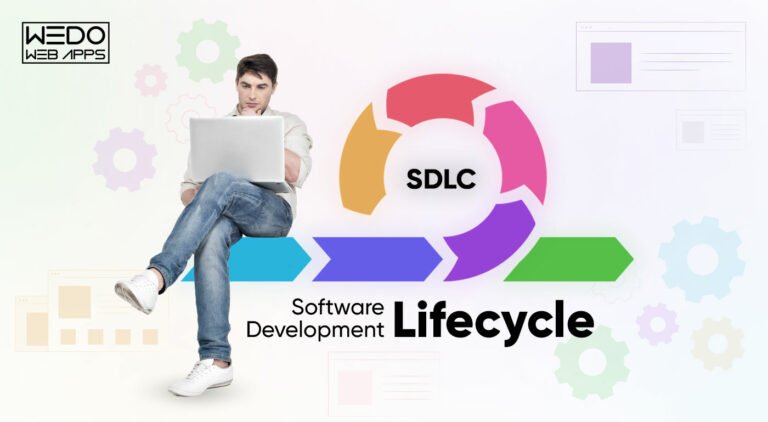16 Jan, 2024 | Mobile App Development
The Software Development Life Cycle (SDLC): 7 Phases and 5 Models

What is the Software Development Life Cycle?
The Software Development Life Cycle (SDLC) is a system that development teams follow. It's to build great software that's high in quality, cost-effective, and timely. The primary aim is to reduce risks during and after software creation. It is also to ensure the software meets customer needs. This process involves making a comprehensive plan to direct the product's development. Then, the development process is divided into smaller parts. These parts can be allocated, finished, and assessed. This makes the entire process more manageable and straightforward.Benefits of Software Development Life Cycle for the Product Team
The Software Development Life Cycle (SDLC) is greatly beneficial for product teams. They often face challenges like adapting to changing requirements, keeping up with new technologies, and working in a collaborative environment. The SDLC offers a structured framework. It helps the product team systematically manage the development process. Each stage of the SDLC has clear objectives and outcomes. By implementing the SDLC, the team can guarantee that everyone involved is on the same page. They will know the software development goals and requirements from the start. This includes stakeholders. There's also a clear strategy to achieve these goals.Using the Software Development Life Cycle (SDLC) offers several key advantages for product teams:
- Enhanced Transparency: The development process becomes more visible to everyone involved, making it easier for all stakeholders to stay informed and involved.
- Better Planning and Timing: The SDLC allows for more accurate and efficient estimation, planning, and scheduling, streamlining the development process.
- Superior Risk and Cost Management: With SDLC, teams can better manage risks and estimate costs. This ensures a smoother development journey.
- Systematic Delivery: The SDLC ensures a methodical approach to creating software. This approach leads to products that meet customer expectations. It also results in higher customer satisfaction.
The 7 Phases of the Software Development Life Cycle
Here's a breakdown of the seven key stages in the Software Development Life Cycle (SDLC). It will make it easier to understand for everyone:1. Idea, Planning and Analysis
At the start of the Software Development Life Cycle (SDLC), we have the planning stage. This is when we gather essential information from clients or stakeholders about what they need. It's crucial to evaluate if the product can be made, how much it might cost, its potential to earn revenue, and how it will meet the end-users' needs. To make smart decisions about what features to include, omit, or prioritize, we can use a feature prioritization method. This method considers the value of the software or update, its cost, the time needed for development, and other key factors. Once we establish that the software project aligns with business and stakeholder objectives, is feasible to develop, and effectively addresses user requirements, we're ready to progress to the next phase.2. Requirements and Analysis
This stage is vital for turning the data collected in the planning and analysis phase into specific requirements for the development team. This step leads to the creation of several essential documents: a Software Requirement Specification (SRS), a Use Case document, and a Requirement Traceability Matrix document. These documents serve as a roadmap for the development process, ensuring that all the team's efforts are aligned with the project's goals and user needs.3. Design and Prototyping
The design stage is when ideas are transformed into a concrete plan. Here, the initial concept and vision are developed into a detailed Software Design Document (SDD). This document covers the system architecture, choice of programming languages, design templates, platform selection, and security measures for the application. It's also the stage where the team creates flowcharts to map out how the software will react to user interactions. Typically, this phase also involves building a prototype. By creating an early version of the product, the team gets a chance to see what the final product might look like. This allows for adjustments and refinements without the need to extensively rewrite code. It makes the development process more efficient and flexible. Understand the seven phases and five models of the software development life cycle, and see how an app development agency in London can guide you through each step.4. Software Development
During the actual development phase, the development team divides the project into different software modules and converts the software requirements into functional code. This is the phase where the product really starts to take shape. This stage of the SDLC can be time-consuming and often requires specialized development tools. Setting a clear timeline with specific milestones is crucial. This helps the software developers understand what is expected of them and allows for effective tracking of progress. In some instances, the development phase overlaps with the testing phase. Various tests are conducted to ensure the absence of critical bugs in the software. Remember, each software development tool has its own strengths and specialties. Choosing the right tool is key to aligning with the specific needs and goals of your project. If you're looking to bring your mobile app idea to life, consider partnering with a seasoned mobile app development company, known for turning visions into successful digital realities.5. Testing
Before launching the software into the live environment, it's crucial for the quality assurance (QA) team to conduct thorough validation testing. This ensures the software works as intended and meets its objectives. The testing phase is also key for identifying and resolving any significant user experience or security issues. In certain scenarios, software testing can be carried out in a simulated setting. This allows for a controlled environment where various aspects of the software can be tested without real-world consequences. Additionally, some simpler tests can be automated, streamlining the testing process and ensuring efficiency and accuracy.In this stage, several types of testing are crucial:
- Performance Testing: This checks how fast and adaptable the software is under various conditions.
- Functional Testing: This ensures the software fulfills all the specified requirements.
- Security Testing: This test looks for any vulnerabilities or weaknesses.
- Unit Testing: This involves testing each unit or component of the software separately.
- Usability Testing: This assesses the software's user interface and overall user experience.
- Acceptance Testing: Also known as end-user testing, beta testing, application testing, or field testing, this is the ultimate test to confirm the software delivers what it's supposed to.
6. Deployment
In the deployment phase, the final version of your software reaches its intended audience. This step can be automated and scheduled according to the nature of the deployment. For instance, if it's just a feature update, you might opt for a canary release, which involves rolling out the update to a small group of users first. On the other hand, if you're launching entirely new software, it's beneficial to familiarize yourself with the various stages of the Software Release Life Cycle (SRLC) to ensure a smooth rollout. Understanding the software development life cycle is crucial for successful projects. Learn how the UCL software database module catalogue can enhance your development process.7. Maintenance and Updates
The maintenance phase is traditionally seen as the final step in the Software Development Life Cycle (SDLC), especially in the waterfall model. However, agile methodologies are shifting the view of maintenance. It is seen as an opportunity for ongoing improvements. During maintenance, users might uncover bugs or errors. These issues weren't caught in earlier testing stages. Addressing these issues is crucial for enhancing user experience and encouraging user retention. Fixing these bugs may even require revisiting the initial stages of the SDLC. Additionally, the SDLC phases might begin anew for incorporating any new features. This is for future releases or updates of the software.Different Models in Software Development
The Software Development Life Cycle (SDLC) comes in several frameworks or "models." Each model organizes the development process uniquely. These models offer structured ways for organizations to implement the SDLC effectively. Let's explore some of the most widely used models in software life cycle management.1. The Agile Model
In the Agile model, the stages of the SDLC are divided into multiple development cycles. During each cycle, the team delivers small, incremental updates to the software. The Agile method is known for its efficiency and quick development cycles. This makes it great for spotting issues early. However, relying too much on customer feedback might result in frequent scope changes. It might even lead to project cancellation. This approach suits software development projects that need a high degree of flexibility. It also suits projects that need the capability to evolve over time.2. The Waterfall Model
The Waterfall model follows a linear and sequential arrangement of the SDLC phases. Each phase starts only after the previous one has been completed. This model brings a clear structure to project management. However, it offers limited flexibility for changes once a phase is finished. Therefore, it's most suitable for smaller projects with well-defined scopes and requirements.3. The Iterative Model
In the Iterative model, development starts with a limited set of requirements. The software is improved through repeated cycles until it's ready for production. This approach facilitates effective risk management. However, the continuous iteration process might result in changes to the project scope. It might also lead to underestimating the resources needed. It's ideal for projects that require high adaptability in requirements. It also has the capacity to manage numerous iterations.4. The Spiral Model
The Spiral model merges the iterative approach's cyclical development. It does this with the linear progression of the Waterfall model. It places a strong emphasis on risk analysis. This method is particularly effective for complex projects that undergo frequent changes. However, due to its comprehensive nature, it can be cost-prohibitive for smaller-scale projects.5. The Big Bang Model Approach
In the Big Bang model, development starts immediately with coding, often with minimal upfront planning. Requirements are tackled as they arise, without a predefined plan. This approach can lead to significant changes or even a complete overhaul of the software if new requirements emerge. This model is not suitable for large-scale projects. However, it fits well with academic or experimental projects. It also works well for smaller projects involving just one or two developers. It's particularly effective in situations where requirements are unclear. Also, there's no fixed deadline for the project's completion. If your project specifically involves mobile applications, consider partnering with a top-notch mobile app development services provider company to ensure your software excels in today's competitive market.Conclusion
In conclusion, the Software Development Life Cycle (SDLC) is a critical framework. It guides software development projects from conception to completion. Product teams can navigate the complex process of software creation with clarity and efficiency. They can do this by understanding and implementing its seven key stages. The seven key stages are Idea, Planning and Analysis, Requirements and Analysis, Design and Prototyping, Software Development, Testing, Deployment, and Maintenance and Updates. In addition, choosing the right SDLC model can greatly impact a project's success. It can be Agile, Waterfall, Iterative, Spiral, or the Big Bang Model. The choice depends on the project's specific needs and challenges. Ultimately, the SDLC provides a structured path for teams to deliver high-quality software. It meets user expectations and evolves with technological advancements.Frequently Asked Questions
The SDLC is a structured process followed by development teams to create high-quality, efficient, and cost-effective software.
There are seven key stages in the SDLC: Idea, Planning and Analysis, Requirements and Analysis, Design and Prototyping, Software Development, Testing, Deployment, and Maintenance and Updates.
The most common models include Agile, Waterfall, Iterative, Spiral, and the Big Bang Model, each with its unique approach to software development.
The choice depends on your project's size, complexity, and flexibility requirements. Agile is great for flexibility, while Waterfall suits well-defined projects.

